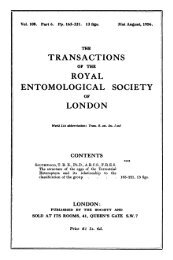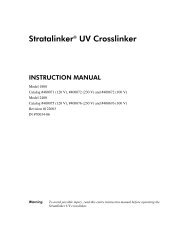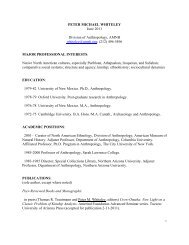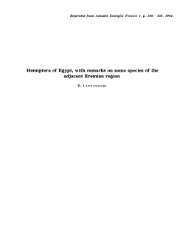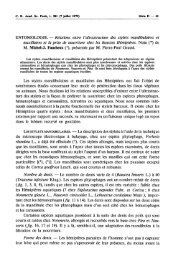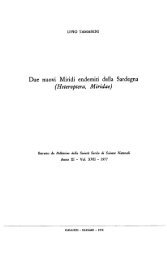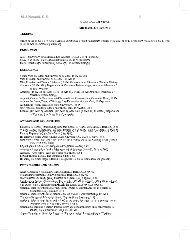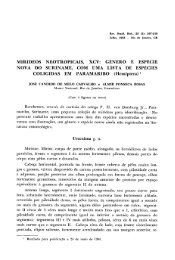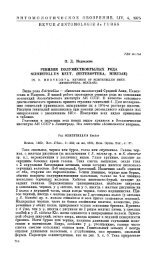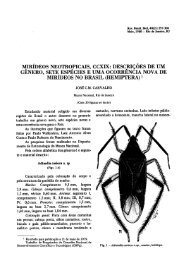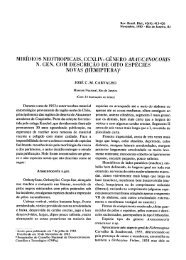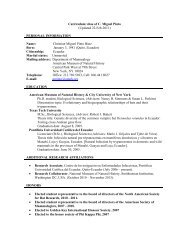Xyloplax is an asteroid - Our Research - American Museum of ...
Xyloplax is an asteroid - Our Research - American Museum of ...
Xyloplax is an asteroid - Our Research - American Museum of ...
You also want an ePaper? Increase the reach of your titles
YUMPU automatically turns print PDFs into web optimized ePapers that Google loves.
<strong>Xyloplax</strong> <strong>is</strong> <strong>an</strong> <strong>asteroid</strong><br />
D<strong>an</strong>iel J<strong>an</strong>ies<br />
Department <strong>of</strong> Invertebrates, Americ<strong>an</strong> <strong>Museum</strong> <strong>of</strong> Natural H<strong>is</strong>tory, New York, NY, USA.<br />
Rich Mooi<br />
Department <strong>of</strong> Invertebrate Zoology <strong>an</strong>d Geology, California Academy <strong>of</strong> Sciences, S<strong>an</strong> Fr<strong>an</strong>c<strong>is</strong>co, CA, USA.<br />
Reprinted from: Echinoderm <strong>Research</strong> 1998. M. C<strong>an</strong>dia Carevali <strong>an</strong>d F. Bonasoro (eds). A.A.Balkema,<br />
Rotterdam, Netherl<strong>an</strong>ds. available at: http://research.amnh.org/~dj<strong>an</strong>ies/j<strong>an</strong>ies&mooi.pdf<br />
ABSTRACT: Concentricycloids are small d<strong>is</strong>k-shaped echinoderms recently d<strong>is</strong>covered on sunken wood from<br />
the abyssal seas <strong>of</strong>f New Zeal<strong>an</strong>d <strong>an</strong>d the Bahamas. Their water-vascular system <strong>is</strong> circular rather th<strong>an</strong><br />
pentaradial as <strong>is</strong> character<strong>is</strong>tic <strong>of</strong> echinoderms. As a result <strong>of</strong> th<strong>is</strong> remarkable body pl<strong>an</strong>, a new class (the sixth<br />
ext<strong>an</strong>t) <strong>of</strong> the Phylum Echinodermata, Concentricycloidea, was erected to accommodate two species <strong>of</strong> genus<br />
<strong>Xyloplax</strong>. Th<strong>is</strong> classification remains controversial because it implies that <strong>Xyloplax</strong> <strong>is</strong> <strong>an</strong> <strong>an</strong>cient group that <strong>is</strong> a<br />
s<strong>is</strong>ter taxon to all <strong>asteroid</strong>s <strong>an</strong>d ophiuroids. We tested the validity <strong>of</strong> the 'class Concentricycloidea' with clad<strong>is</strong>tic<br />
<strong>an</strong>alyses <strong>of</strong> nucleotide sequences <strong>an</strong>d morphology from exemplars <strong>of</strong> most echinoderm orders. <strong>Xyloplax</strong> <strong>is</strong><br />
nested within a monophyletic Asteroidea in the most congruent total evidence tree. Thus the r<strong>an</strong>k <strong>of</strong> class <strong>is</strong> <strong>an</strong><br />
inappropriate representation <strong>of</strong> the evolutionary h<strong>is</strong>tory <strong>of</strong> the concentricycloids <strong>an</strong>d should be suppressed.<br />
Moreover, these results suggest that fundamental features <strong>of</strong> body org<strong>an</strong>ization were labile late in the<br />
diversification <strong>of</strong> the <strong>asteroid</strong>s.<br />
1 INTRODUCTION<br />
In 1986, Baker et al. reported the d<strong>is</strong>covery <strong>of</strong> <strong>an</strong><br />
unusual echinoderm on sunken wood from the South<br />
Pacific Oce<strong>an</strong> <strong>an</strong>d Tasm<strong>an</strong> Sea (1057-1208 m) <strong>of</strong>f the<br />
North <strong>an</strong>d South Isl<strong>an</strong>ds <strong>of</strong> New Zeal<strong>an</strong>d. Th<strong>is</strong><br />
<strong>an</strong>imal, <strong>Xyloplax</strong> medusiform<strong>is</strong>, was classified in the<br />
subphylum Asterozoa [sensu Ubaghs (1966) = class<br />
a b<br />
SPINE<br />
HYDROPORE<br />
TERMINAL<br />
TERMINAL PODIUM<br />
MID-RADIAL<br />
ORAL<br />
CENTRODORSAL<br />
INTERRADIAL<br />
AMBULACRAL<br />
ADAMBULACRAL<br />
PODIUM<br />
Asteroidea, Ophiuroidea, <strong>an</strong>d the extinct class<br />
Som<strong>asteroid</strong>ea] but was considered sufficiently<br />
d<strong>is</strong>tinct to warr<strong>an</strong>t exclusion from these classes. A<br />
second species, <strong>Xyloplax</strong> turnerae, was later<br />
recognized from collections <strong>of</strong> fauna associated with<br />
sunken wood from the Tongue <strong>of</strong> the Oce<strong>an</strong> (2066 m)<br />
<strong>of</strong>f Andros Isl<strong>an</strong>d, Bahamas (Rowe et al. 1988).<br />
TERMINAL<br />
Figure 1. Morphology <strong>of</strong> adult <strong>Xyloplax</strong> turnerae. a: Oral surface, axial elements shaded. b: Oral view <strong>of</strong><br />
skeletal elements from a single half-ambulacrum <strong>of</strong> a specimen in MCZ 12013, spines omitted.<br />
ORAL<br />
AMBULACRAL<br />
ADAMBULACRAL<br />
PODIAL PORE<br />
ODONTOPHORE
Both species <strong>of</strong> <strong>Xyloplax</strong> are small (≈ 2-13 mm<br />
diameter) for sexually mature echinoderms (Fig. 1).<br />
Growth <strong>of</strong> the axial portions <strong>of</strong> the water-vascular<br />
system <strong>an</strong>d associated skeleton from the tips <strong>of</strong> the<br />
ambulacra <strong>an</strong>d the emergence <strong>of</strong> podia between plates<br />
clearly places <strong>Xyloplax</strong> within the subphylum<br />
Asterozoa (Baker et al. 1986; Rowe et al. 1988; Mooi<br />
et al. 1998). However, <strong>Xyloplax</strong> lacks radiating arms<br />
<strong>an</strong>d water-vascular c<strong>an</strong>als typical <strong>of</strong> adult <strong>asteroid</strong>s<br />
<strong>an</strong>d ophiuroids (Fig. 2a). Diagnostic features <strong>of</strong> the<br />
'class Concentricycloidea' included the arr<strong>an</strong>gement <strong>of</strong><br />
the skeletal plates <strong>an</strong>d the water-vascular system. As<br />
originally described, the water-vascular system <strong>of</strong><br />
<strong>Xyloplax</strong> cons<strong>is</strong>ts <strong>of</strong> two circumoral ring c<strong>an</strong>als<br />
supposedly joined by five short inter-ring c<strong>an</strong>als. The<br />
podia <strong>of</strong> adult <strong>Xyloplax</strong> br<strong>an</strong>ch from the outer<br />
circumoral ring c<strong>an</strong>al in a single series that<br />
circumscribes the periphery <strong>of</strong> the oral surface. In<br />
<strong>Xyloplax</strong> a simple hydropore (a structure typical <strong>of</strong><br />
larvae) connects the inner circumoral ring c<strong>an</strong>al to<br />
external sea water (Fig. 2a).<br />
The water-vascular system <strong>of</strong> asterozo<strong>an</strong>s cons<strong>is</strong>ts<br />
<strong>of</strong> a single circumoral ring c<strong>an</strong>al with <strong>an</strong> axial complex<br />
including <strong>an</strong> axocoel (<strong>an</strong> adult derivative <strong>of</strong> the larval<br />
hydropore) that connects the water-vascular system to<br />
external sea water. In asterozo<strong>an</strong>s the water-vascular<br />
system cons<strong>is</strong>ts <strong>of</strong> five (or more in species with<br />
supernumerary arms) radial c<strong>an</strong>als that extend from<br />
the circumoral c<strong>an</strong>al into the arms. In each arm, lateral<br />
c<strong>an</strong>als connect a b<strong>is</strong>erial row <strong>of</strong> podia to the radial<br />
c<strong>an</strong>als (Fig. 2b).<br />
X. medusiform<strong>is</strong> lacks a stomach, intestine, <strong>an</strong>d<br />
<strong>an</strong>us. As described, there <strong>is</strong> a thin layer <strong>of</strong> coelomic<br />
t<strong>is</strong>sue attached to the ossicles <strong>of</strong> the mouth frame.<br />
Th<strong>is</strong> t<strong>is</strong>sue <strong>is</strong> termed a velum, yet its role in feeding<br />
<strong>an</strong>d/or locomotion <strong>is</strong> unknown. X. turnerae lacks <strong>an</strong><br />
intestine <strong>an</strong>d <strong>an</strong>us yet has a stomach that appears to be<br />
capable <strong>of</strong> eversible feeding (Baker et al. 1986; Rowe<br />
et al. 1988). Eversible feeding <strong>is</strong> common among<br />
<strong>asteroid</strong>s <strong>an</strong>d lack <strong>of</strong> <strong>an</strong> <strong>an</strong>us occurs in the order<br />
Paxillosida. The taxonomic position <strong>of</strong> <strong>Xyloplax</strong> has<br />
been extremely controversial in the few years since<br />
a<br />
POLIAN VESICLE<br />
INNER CIRCUMORAL RING<br />
HYDROPORE<br />
OUTER CIRCUMORAL RING<br />
AMPULLA<br />
INTER-RING CANAL<br />
CIRCUMORAL RING<br />
d<strong>is</strong>covery. Various hypotheses are summarized<br />
below:<br />
1) A new class: The d<strong>is</strong>covers <strong>of</strong> <strong>Xyloplax</strong> argued<br />
that features such as: two circumoral c<strong>an</strong>als, inter-ring<br />
c<strong>an</strong>als, un<strong>is</strong>erial peripheral ring <strong>of</strong> podia, modified<br />
mouth-frame skeleton, <strong>an</strong>d modified digestive <strong>an</strong>d<br />
feeding structures warr<strong>an</strong>t taxonomic d<strong>is</strong>tinction<br />
between <strong>Xyloplax</strong> <strong>an</strong>d asterozo<strong>an</strong>s. Thus <strong>Xyloplax</strong><br />
should be set apart as a new (the sixth ext<strong>an</strong>t)<br />
echinoderm class - the Concentricycloidea (Baker et<br />
al. 1986; Rowe et al. 1988; Rowe 1989; Pearse &<br />
Pearse 1994). Th<strong>is</strong> view has pervaded textbooks (e.g.<br />
Brusca & Brusca 1990; Harr<strong>is</strong>on & Chia 1994).<br />
2) Aberr<strong>an</strong>t <strong>asteroid</strong>s: A morphological clad<strong>is</strong>tic<br />
<strong>an</strong>alys<strong>is</strong> <strong>of</strong> limited context (only the <strong>asteroid</strong> order<br />
Velatida) placed <strong>Xyloplax</strong> as s<strong>is</strong>ter group to the<br />
Caym<strong>an</strong>ostellidae (Smith 1988). The unique body<br />
pl<strong>an</strong> <strong>of</strong> <strong>Xyloplax</strong> <strong>is</strong> likely the result <strong>of</strong><br />
paedomorphos<strong>is</strong> (Smith 1988) in velatids which<br />
exhibit extreme direct development (J<strong>an</strong>ies &<br />
McEdward 1994).<br />
3) A new <strong>asteroid</strong> order: Belyaev (1990)<br />
suggested that wood-dwelling, deep-sea <strong>asteroid</strong><br />
families, Xyloplacidae <strong>an</strong>d Caym<strong>an</strong>ostellidae, should<br />
be separated into a new order, Peripoidoidea, within<br />
the class Asteroidea.<br />
The identification <strong>of</strong> morphological characters that<br />
may be informative <strong>of</strong> the h<strong>is</strong>tory <strong>of</strong> <strong>Xyloplax</strong> <strong>is</strong><br />
difficult because its morphology <strong>is</strong> enigmatic.<br />
The original descriptions <strong>of</strong> the internal structure <strong>of</strong><br />
<strong>Xyloplax</strong> have not been confirmed by our own recent<br />
observations. The outer circumoral ring <strong>is</strong> clearly a<br />
water-vascular ring that produces lateral c<strong>an</strong>als,<br />
ampullae, <strong>an</strong>d podia. However, the inner ring <strong>is</strong> not<br />
unequivocally hydrocoel. Further work <strong>is</strong> warr<strong>an</strong>ted<br />
to explore the possibility that the inner ring <strong>is</strong> part <strong>of</strong> a<br />
haemal system, which has yet to be found in <strong>Xyloplax</strong>.<br />
The need for th<strong>is</strong> work <strong>is</strong> underscored by our inability<br />
to positively identify the inter-ring c<strong>an</strong>als. Studies are<br />
under way (Mooi, David, <strong>an</strong>d Rowe in prep.) that will<br />
exp<strong>an</strong>d upon the earlier<br />
b<br />
AMPULLA<br />
MADREPORITE<br />
RADIAL CANAL<br />
Figure 2. Compar<strong>is</strong>on <strong>of</strong> adult water-vascular morphology. a: Concentricycloids (based on original<br />
descriptions <strong>of</strong> <strong>Xyloplax</strong> turnerae (Rowe et al. 1988). b: Other asterozo<strong>an</strong>s (based on <strong>asteroid</strong>s).
descriptions <strong>of</strong> Baker et al. (1986); Rowe et al.<br />
(1988); <strong>an</strong>d Mooi et al. (1988).<br />
The class level clad<strong>is</strong>tic <strong>an</strong>alys<strong>is</strong> <strong>of</strong> Pearse &<br />
Pearse (1994) placed <strong>Xyloplax</strong> in a trichotomy with<br />
<strong>asteroid</strong>s <strong>an</strong>d ophiuroids due to lack <strong>of</strong> resolution in<br />
the consensus <strong>of</strong> their equally parsimonious trees<br />
rather th<strong>an</strong> unambiguous character support.<br />
The adult skeletal morphology <strong>of</strong> <strong>Xyloplax</strong><br />
turnerae has been recently redescribed (Mooi et al.<br />
1998). Import<strong>an</strong>t ch<strong>an</strong>ges in the description <strong>of</strong> the<br />
axial skeleton include: 1) plates that bear the podia are<br />
ambulacrals, 2) the outermost ring <strong>of</strong> plates are<br />
adambulacrals, 3) the innermost, large ossicles are oral<br />
plates <strong>an</strong>d are derived from the adambulacral series.<br />
The first two characters add to the l<strong>is</strong>t <strong>of</strong> asterozo<strong>an</strong><br />
features for <strong>Xyloplax</strong> but do not place it within either<br />
the class Asteroidea or Ophiuroidea. Although Mooi<br />
et al. (1998) make no argument for the taxonomic<br />
rev<strong>is</strong>ion <strong>of</strong> <strong>Xyloplax</strong>, the third suggestion that the large<br />
plates they term 'oral plates' <strong>of</strong> <strong>Xyloplax</strong> are modified<br />
adambulacral plates has import<strong>an</strong>t ramifications for<br />
the inclusion <strong>of</strong> <strong>Xyloplax</strong> within Asteroidea. Several<br />
authors contend that the oral plates <strong>of</strong> <strong>asteroid</strong>s are<br />
derived from the adambulacral series whereas the oral<br />
plates <strong>of</strong> ophiuroids are derived from the ambulacral<br />
series (Spencer & Wright 1966; Blake 1998).<br />
However, the mouth frame <strong>of</strong> Asterozoa <strong>is</strong> poorly<br />
understood as a character system <strong>an</strong>d merits complete<br />
rev<strong>is</strong>ion.<br />
2 METHODS<br />
2.1 DNA Sequencing<br />
DNA was extracted from aldehyde/eth<strong>an</strong>ol preserved<br />
fragments <strong>of</strong> the ambulacra <strong>of</strong> the concentricycloid,<br />
a<br />
Echinoidea<br />
Holothuroidea<br />
b<br />
Ophiuroidea<br />
Asteroidea<br />
(including <strong>Xyloplax</strong> )<br />
Crinoidea<br />
Rhabdopleura<br />
Enteropneusta<br />
Echinodermata<br />
Hemichordata<br />
<strong>Xyloplax</strong> turnerae (MCZ lot 12007). Partial gene<br />
regions corresponding to positions 140-250 <strong>an</strong>d<br />
1139-1394 <strong>of</strong> the 18S rDNA sequence <strong>of</strong><br />
Amphiphol<strong>is</strong> squamata (Genb<strong>an</strong>k accession X97156)<br />
<strong>an</strong>d positions 807 <strong>an</strong>d 1125 <strong>of</strong> the 28S rDNA<br />
sequence <strong>of</strong> Encope aberr<strong>an</strong>s (Genb<strong>an</strong>k accession<br />
Z37117) were amplified with PCR <strong>an</strong>d sequenced on<br />
<strong>an</strong> ABI 373 automated DNA sequencer using the<br />
methods described in m<strong>an</strong>ufacturer's protocols<br />
(Perkin-Elmer/Applied Biosystems Pr<strong>is</strong>m kit). After<br />
sequences were obtained from <strong>Xyloplax</strong> turnerae,<br />
DNA was extracted with the same protocol <strong>an</strong>d 18S<br />
<strong>an</strong>d or 28S rDNA was sequenced for the following<br />
species: Amphiphol<strong>is</strong> squamata, Gorgonocephalus<br />
eucnem<strong>is</strong>, Cucumaria pseudocurata, Br<strong>is</strong>ingaster<br />
robillardi, Asterias forbesi, Pteraster obscurus,<br />
Pseudarchaster parelli, Rathbunaster californicus,<br />
Dermasterias imbricata, Echinaster sepositus,<br />
Solaster dawsonii, Astropecten articulatus, Asterina<br />
gibbosa, Luidia foliolata, Heliaster heli<strong>an</strong>thoides,<br />
Dorometra aegyptica, Capillaster multiradiatus, <strong>an</strong>d<br />
Antedon mediterr<strong>an</strong>ea. Unpubl<strong>is</strong>hed 18S rDNA<br />
Glossobal<strong>an</strong>us minutus sequence was provided by<br />
Gonzalo Giribet (AMNH).<br />
2.2 Morphology <strong>an</strong>d non-sequence character data<br />
A total <strong>of</strong> 62 non-sequence characters (hereafter<br />
referred to as 'characters') for echinoderms were<br />
drawn largely from literature sources but several<br />
(especially larval characters) are original. Eight<br />
characters are unordered mult<strong>is</strong>tate <strong>an</strong>d 54 are binary.<br />
Morphological characters were coded or recoded for<br />
each terminal taxon represented by DNA sequences.<br />
Mitochondrial gene order characters are provided only<br />
in those taxa in which the observation was made<br />
(except for crinoids).<br />
Echinoidea<br />
Holothuroidea<br />
Asteroidea<br />
(including <strong>Xyloplax</strong> )<br />
Ophiuroidea<br />
Crinoidea<br />
Hemichordata<br />
Figure 3. Results <strong>of</strong> <strong>an</strong>alyses <strong>of</strong> various data types. a. Summary <strong>of</strong> most parsimonious topology supported by<br />
nonsequence character data (92 steps). b. Summary <strong>of</strong> most congruent topology supported by 18S <strong>an</strong>d 28S<br />
rDNA data (MFES = 0.0174). In both <strong>an</strong>alyses <strong>Xyloplax</strong> <strong>is</strong> nested within the class Asteroidea.<br />
Echinodermata
2.3 Taxonomic sampling<br />
A thorough investigation <strong>of</strong> the evolutionary h<strong>is</strong>tory <strong>of</strong><br />
<strong>Xyloplax</strong> among Echinodermata required sampling<br />
m<strong>an</strong>y lineages. 44 partial <strong>an</strong>d complete 18S rDNA<br />
sequences <strong>an</strong>d 30 partial 28S rDNA sequences were<br />
<strong>an</strong>alyzed. These sequences exemplify: 10 <strong>of</strong> 12<br />
orders <strong>of</strong> the class Echinoidea, 7 <strong>of</strong> 17 families <strong>of</strong> the<br />
class Ophiuroidea, 6 <strong>of</strong> 7 orders <strong>of</strong> the class<br />
Asteroidea, 3 <strong>of</strong> 6 orders <strong>of</strong> Holothuroidea, <strong>an</strong>d 2 <strong>of</strong> 4<br />
orders <strong>of</strong> the class Crinoidea. Hemichordates are<br />
represented by three full 18S rDNA sequences from<br />
the class Enteropneusta <strong>an</strong>d one partial sequence <strong>of</strong><br />
18S rDNA for the class Pterobr<strong>an</strong>chia, Rhabdopleura<br />
norm<strong>an</strong>i. Hemichordates were chosen as the<br />
outgroup to echinoderms because th<strong>is</strong> relationship<br />
occurs in recent molecular phylogeny (Giribet &<br />
Ribera, 1998) <strong>an</strong>d in molecular <strong>an</strong>d morphological<br />
studies (Zrzavy et al. 1998) with well sampled<br />
metazo<strong>an</strong> exemplars.<br />
2.4 Analyses<br />
Analys<strong>is</strong> <strong>of</strong> the character data in NONA (Golob<strong>of</strong>f<br />
1993) yielded 5041 equally parsimonious topologies<br />
at 92 steps. A strict consensus <strong>of</strong> these topologies <strong>is</strong><br />
summarized in Figure 3a. These topologies lack<br />
resolution within classes. The presence <strong>of</strong> the<br />
odontophore, <strong>an</strong> interradial mouth frame ossicle,<br />
supports the monophyly <strong>of</strong> the Asteroidea. Th<strong>is</strong> clade<br />
includes <strong>Xyloplax</strong>, as it has a prominent odontophore<br />
in the interradial position, prec<strong>is</strong>ely as in <strong>asteroid</strong>s<br />
(Fig. 1a). One synapomorphy, the absence <strong>of</strong> <strong>an</strong> <strong>an</strong>us<br />
in adults, supports the clade (<strong>Xyloplax</strong> (Astropecten<br />
Luidia)).Genb<strong>an</strong>k/Embl/DDJB accession numbers for<br />
each region sequenced <strong>an</strong>d <strong>an</strong>alyzed are provided in a<br />
table <strong>of</strong> supplementary information available from the<br />
authors. Unaligned sequence data were subjected to<br />
direct optimization <strong>an</strong>alys<strong>is</strong> in POY on a cluster <strong>of</strong> 23<br />
UNIX-based workstations <strong>of</strong> heterogeneous<br />
architectures integrated into a parallel virtual machine<br />
(Ge<strong>is</strong>t et al. 1993). A total <strong>of</strong> 20 parameter sets were<br />
explored. The ratio <strong>of</strong> weights among indels <strong>an</strong>d the<br />
greater <strong>of</strong> tr<strong>an</strong>sversion or tr<strong>an</strong>sition weights r<strong>an</strong>ged<br />
from 1 to 8. The tr<strong>an</strong>sversion: tr<strong>an</strong>sition ratios r<strong>an</strong>ged<br />
between 0.5 <strong>an</strong>d 4. Some parameter sets were set to<br />
examine tr<strong>an</strong>sversion parsimony (i.e. tr<strong>an</strong>sitions were<br />
set at 0 cost yielding a tr<strong>an</strong>sversion: tr<strong>an</strong>sition ratio <strong>of</strong><br />
∞). Character data weights r<strong>an</strong>ged from 1 to a<br />
variable cost pegged to the cost <strong>of</strong> indels. Sequence<br />
data were also <strong>an</strong>alyzed without character data as the<br />
following data partitions 18S + 28S, 18S only, <strong>an</strong>d<br />
28S only. Character data were <strong>an</strong>alyzed as a single<br />
partition. The addition <strong>of</strong> taxa (including putative<br />
outgroups) was r<strong>an</strong>domized during the build <strong>an</strong>d<br />
swapping<br />
processes for molecular data <strong>an</strong>d during swapping for<br />
molecular <strong>an</strong>d morphological data. Tree searches<br />
included TBR <strong>an</strong>d SPR swapping.<br />
Character congruence, <strong>an</strong> extension <strong>of</strong> parsimony,<br />
was used as the optimality criterion for choosing<br />
among various topologies that are produced. The<br />
Mickevitch - Farr<strong>is</strong> extra steps index (MFES)<br />
measures the number <strong>of</strong> extra steps that occur in <strong>an</strong><br />
<strong>an</strong>alys<strong>is</strong> <strong>of</strong> combined data versus separate <strong>an</strong>alys<strong>is</strong> <strong>of</strong><br />
individual partitions (Mickevitch & Farr<strong>is</strong> 1981). As<br />
character incongruence among data partitions<br />
increases, MFES increases. The number <strong>of</strong> extra<br />
steps <strong>is</strong> normalized by the length <strong>of</strong> the combined<br />
<strong>an</strong>alys<strong>is</strong>. Therefore when parameter sensitivity<br />
<strong>an</strong>alyses are conducted on the same data partitions,<br />
MFES scores are comparable despite different<br />
weighting schemes. In th<strong>is</strong> study the test was<br />
conducted for morphological <strong>an</strong>d sequence data as<br />
follows (Equation 1):<br />
3 Results<br />
Combined <strong>an</strong>alyses <strong>of</strong> the 18S <strong>an</strong>d 28S rDNA<br />
sequences across 20 parameter sets (graded variations<br />
<strong>of</strong> cost ratios i.e. indels: tr<strong>an</strong>sversion: tr<strong>an</strong>sition) in<br />
POY (Gladstein & Wheeler 1996) yielded a single<br />
most congruent topology (MFES = 0.0174) when<br />
indels, tr<strong>an</strong>sversions, <strong>an</strong>d tr<strong>an</strong>sitions were weighted at<br />
1. Th<strong>is</strong> topology <strong>is</strong> summarized in Figure 3b.<br />
Combined <strong>an</strong>alyses <strong>of</strong> the 18S <strong>an</strong>d 28S rDNA<br />
sequences character data weighted at 1 across 20<br />
parameter sets in POY yielded 6 most congruent<br />
topologies (MFES = 1.86) when insertion-deletion<br />
events <strong>an</strong>d tr<strong>an</strong>sversions were weighted at 2 <strong>an</strong>d<br />
tr<strong>an</strong>sitions were weighted at 1. A strict consensus <strong>of</strong><br />
these topologies with br<strong>an</strong>ch decay values (Bremer<br />
1988) at nodes <strong>is</strong> presented in Figure 4.<br />
Heur<strong>is</strong>tic br<strong>an</strong>ch decay values were calculated for<br />
the most congruent trees based on a TBR search in<br />
POY rather th<strong>an</strong> via collapsing equivocal nodes from<br />
evermore inclusive br<strong>an</strong>ch <strong>an</strong>d bound searches. As a<br />
result these values may overestimate group support.<br />
4 Conclusions<br />
<strong>Xyloplax</strong> <strong>is</strong> <strong>an</strong> <strong>asteroid</strong> in the shortest tree <strong>an</strong>d the<br />
result <strong>is</strong> not the consequence <strong>of</strong> <strong>an</strong> arbitrary choice <strong>of</strong><br />
evolutionary model (in th<strong>is</strong> case the parameter sets<br />
included weights <strong>of</strong> insertion-deletion events,<br />
nucleotide tr<strong>an</strong>sformations, <strong>an</strong>d ch<strong>an</strong>ges in<br />
morphological <strong>an</strong>d other character data). In the most<br />
congruent total evidence tree <strong>Xyloplax</strong> <strong>is</strong> s<strong>is</strong>ter taxon<br />
to Rathbunaster, <strong>an</strong> exemplar <strong>of</strong> the order<br />
Forcipulatida (Fig. 4). The clade, Asteroidea including<br />
<strong>Xyloplax</strong>, <strong>is</strong> recovered under almost all <strong>an</strong>alys<strong>is</strong><br />
parameters that recover <strong>asteroid</strong> monophyly (fig. 5).<br />
MFES= (treelength combined data) − (treelength 18S) − (treelength 28S) − (treelength nonsequence characters)<br />
(treelength combined data)<br />
(1)
28<br />
14<br />
Solaster<br />
Crossaster<br />
Asterina<br />
Rathbunaster<br />
20 <strong>Xyloplax</strong><br />
8<br />
Asterias<br />
Br<strong>is</strong>ingaster<br />
12<br />
17<br />
Echinaster<br />
Pteraster<br />
Astropecten<br />
2 Luidia<br />
50<br />
11 Heliaster<br />
Pseudarchaster<br />
Dermasterias<br />
Por<strong>an</strong>ia<br />
3<br />
5<br />
5<br />
Ophiomyxa<br />
Ophioc<strong>an</strong>ops<br />
Ophioplocus<br />
56<br />
3<br />
6<br />
Amphiphol<strong>is</strong><br />
Ophiophol<strong>is</strong><br />
Astrobrachion<br />
54 Gorgonocephalus<br />
8<br />
Encope<br />
Cassidulus<br />
Echinocardium<br />
Stomopneustes<br />
Psammechinus<br />
Mespilia<br />
Arbacia<br />
Eucidar<strong>is</strong><br />
Diadema<br />
Asthenosoma<br />
Lipotrapeza<br />
Cucumaria<br />
10<br />
12<br />
14<br />
12<br />
8<br />
9<br />
16<br />
8<br />
7<br />
62 7<br />
53<br />
23 56<br />
190<br />
88<br />
Asteroidea<br />
Asterozoa<br />
Ophiuroidea<br />
Eleutherozoa<br />
Echinoidea<br />
Echinodermata<br />
Echinozoa<br />
Holothuroidea<br />
Crinoidea<br />
8<br />
9<br />
52<br />
Hemichordata 23<br />
53<br />
25<br />
Stichopus<br />
Psychropotes<br />
Dorometra<br />
Capillaster<br />
Antedon<br />
Endoxocrinus<br />
Bal<strong>an</strong>oglossus<br />
Glossobal<strong>an</strong>us<br />
Rhabdopleura<br />
Saccloglossus<br />
Figure 4. Strict consensus <strong>of</strong> binary trees for most<br />
congruent topologies for Echinodermata based on<br />
combined <strong>an</strong>alys<strong>is</strong> <strong>of</strong> 18S + 28S rDNA +<br />
nonsequence character data (MFES = 0.0186).<br />
<strong>Xyloplax</strong> <strong>is</strong> nested within the class Asteroidea.<br />
Bremer support values are provided below nodes or at<br />
the nodes at the end <strong>of</strong> arrows. There <strong>is</strong> strong<br />
Bremer support for the phylum Echinodermata <strong>an</strong>d its<br />
five component classes <strong>an</strong>d the phylum Hemichordata.<br />
There <strong>is</strong> moderate Bremer support for the subphyla<br />
Echinozoa <strong>an</strong>d Eleutherozoa. Bremer support <strong>is</strong> weak<br />
for the subphylum Asterozoa.<br />
M<strong>an</strong>y clades such as the Eleutherozoa, Echinozoa,<br />
<strong>an</strong>d Asteroidea including <strong>Xyloplax</strong>, Ophiuroidea, <strong>an</strong>d<br />
Crinoidea are stable to choice <strong>of</strong> <strong>an</strong>alys<strong>is</strong> parameters.<br />
However relationships within the stellate forms<br />
(<strong>asteroid</strong>s <strong>an</strong>d ophiuroids) <strong>an</strong>d between stellate forms<br />
<strong>an</strong>d other echinoderms are less robust to parameter<br />
sensitivity <strong>an</strong>alys<strong>is</strong>. These relationships will require<br />
signific<strong>an</strong>t further study. The data <strong>an</strong>d <strong>an</strong>alyses<br />
presented herein are cons<strong>is</strong>tent with the hypotheses<br />
that <strong>Xyloplax</strong> <strong>is</strong> paedomorphic (Smith 1988; J<strong>an</strong>ies &<br />
McEdward 1994). Import<strong>an</strong>t aspects <strong>of</strong> the <strong>an</strong>atomy<br />
<strong>an</strong>d development <strong>of</strong> <strong>Xyloplax</strong> must also be confirmed<br />
by new observations.<br />
ch<strong>an</strong>ge ratio<br />
log (TV cost: TS cost)<br />
2<br />
∞<br />
2<br />
1<br />
0<br />
-1<br />
∞<br />
2<br />
1<br />
0<br />
-1<br />
Clades Recovered<br />
18S + 28S + (morphology @ 1)<br />
Ophiuroidea<br />
0 1 2 3<br />
Ophiuroidea +<br />
<strong>Xyloplax</strong><br />
0 1 2 3<br />
Asteroidea<br />
Asteroidea +<br />
<strong>Xyloplax</strong><br />
gap ratio<br />
log (indel cost: ch<strong>an</strong>ge cost)<br />
2<br />
Figure 5. Summary <strong>of</strong> groups recovered under<br />
various <strong>an</strong>alytical conditions. The recovery <strong>of</strong> a<br />
monophyletic group <strong>is</strong> designated by a black square.<br />
Although monophyletic ophiuroids are recovered<br />
under m<strong>an</strong>y conditions <strong>Xyloplax</strong> <strong>is</strong> never among th<strong>is</strong><br />
taxon. <strong>Xyloplax</strong> <strong>is</strong> recovered as <strong>an</strong> <strong>asteroid</strong> in most <strong>of</strong><br />
the conditions under which <strong>asteroid</strong> monophyly <strong>is</strong><br />
recovered.
REFERENCES<br />
Baker, A.N., F.W.E Rowe & H.E.S. Clark 1986. A<br />
new class <strong>of</strong> Echinodermata from New Zeal<strong>an</strong>d.<br />
Nature. 321: 862-864.<br />
Belyaev, G.M. 1990. Is it Valid to Isolate the Genus<br />
<strong>Xyloplax</strong> as a Separate class <strong>of</strong> Echinoderms?<br />
Zoologicheskii Zhurnal. 69:83-96.<br />
Blake, D. 1998. Morphological characters <strong>of</strong> early<br />
<strong>asteroid</strong>s <strong>an</strong>d ophiuroids. in Echinoderms: S<strong>an</strong><br />
Fr<strong>an</strong>c<strong>is</strong>co. Mooi, R. & Telford, M. eds. A.A.<br />
Balkema, Rotterdam. pp. 5-7.<br />
Bremer, K. 1988. The limits <strong>of</strong> amino acid sequence<br />
data in <strong>an</strong>giosperm phylogenetic reconstruction.<br />
Evolution. 42:795-803.<br />
Brusca R.C. & G.J Brusca 1990. Invertebrates.<br />
Sinauer, Sunderl<strong>an</strong>d, MA.<br />
Ge<strong>is</strong>t, A., J. J. Beguelin, W. Dongarra, R. Ji<strong>an</strong>g, V<br />
M<strong>an</strong>chek, <strong>an</strong>d V.S. Sunderam 1993. PVM 3<br />
user's guide <strong>an</strong>d reference m<strong>an</strong>ual. Technical<br />
Report ORNL/TM-12187, Oak Ridge National<br />
Laboratory.<br />
Giribet, G. & C. Ribera 1998. The position <strong>of</strong><br />
arthropods in the <strong>an</strong>imal kingdom: a search for a<br />
reliable outgroup for internal arthropod phylogeny.<br />
Mol. Phylo. <strong>an</strong>d Evol. 3:481-488.<br />
Gladstein, D. & W. Wheeler 1996. POY native code<br />
version 2.0. Available <strong>an</strong>onymously via<br />
ftp://ftp.amnh.org/pub/molecular/poy.<br />
Golob<strong>of</strong>f, P. 1993. NONA v1.5.1. Americ<strong>an</strong><br />
<strong>Museum</strong> <strong>of</strong> Natural H<strong>is</strong>tory.<br />
Harr<strong>is</strong>on, F.W. & F-S. Chia 1994. Microscopic<br />
Anatomy <strong>of</strong> Invertebrates vol. 14 Echinodermata.<br />
Wiley-L<strong>is</strong>s, New York.<br />
J<strong>an</strong>ies, D. A. & L. R. McEdward 1994. Heterotopy,<br />
pelagic direct development, <strong>an</strong>d new body pl<strong>an</strong>s in<br />
velatid <strong>asteroid</strong>s, in Echinoderms Through Time,<br />
David, B. Guille, A. Féral, J.P. & Roux, M. eds.<br />
A.A. Balkema, Rotterdam. pp. 319-324.<br />
Mickevitch, M.F. & J.S. Farr<strong>is</strong> 1981. The<br />
implications <strong>of</strong> congruence in Menidia. Sys. Zoo.<br />
30: 351-370.<br />
Mooi, R., F.W.E. Rowe, & B. David 1998.<br />
Application <strong>of</strong> a theory <strong>of</strong> axial <strong>an</strong>d extraaxial<br />
skeletal homologies to concentricycloid<br />
morphology. in Echinoderms: S<strong>an</strong> Fr<strong>an</strong>c<strong>is</strong>co.<br />
Mooi, R. & Telford, M. eds. A.A. Balkema,<br />
Rotterdam. pp. 61-62.<br />
Nichols, D. 1986. A new class <strong>of</strong> echinoderms.<br />
Nature. 321: 808.<br />
Pearse V.B. & J.S. Pearse 1994. Echinoderm<br />
phylogeny <strong>an</strong>d the place <strong>of</strong> concentricycloids. in:<br />
Echinoderms Through Time. David, B. Guille, A.<br />
Féral, J.P. & Roux, M. eds. A.A. Balkema,<br />
Rotterdam. pp. 121-126.<br />
Rowe, F.W.E. 1989. A review <strong>of</strong> the family<br />
Caym<strong>an</strong>ostellidae (Echinodermata: Asteroidea)<br />
with a description <strong>of</strong> a new species <strong>of</strong><br />
Caym<strong>an</strong>ostella Belyaev <strong>an</strong>d a new genus. Proc.<br />
Linn. Soc. N.S.W. 111: 293-307.<br />
Rowe, F.W.E., A.N. Baker, & H.E.S. Clark 1988.<br />
The morphology, development <strong>an</strong>d taxonomic<br />
status <strong>of</strong> <strong>Xyloplax</strong> Baker, Rowe, & Clark (1986)<br />
(Echinodermata: Concentricycloidea), with the<br />
description <strong>of</strong> a new species. Proc. R. Soc. Lond.<br />
B. 223: 431-439.<br />
Rowe, F.W.E., D. Nichols, & M. J<strong>an</strong>goux 1982.<br />
Anatomy <strong>of</strong> the Spherical, Valvatid Starf<strong>is</strong>h,<br />
Podosphaeraster (Echinodermata; Asteroidea)<br />
with comments on the Affinities <strong>of</strong> the Genus.<br />
Micronesia. 18: 83-93.<br />
Smith, A.B. 1988. To group or not to group: The<br />
taxonomic position <strong>of</strong> <strong>Xyloplax</strong>. in Echinoderm<br />
Biology. Burke R.D., Mladenov P.V., Lambert, P.,<br />
& Parsley, R.L. eds. A.A. Balkema, Rotterdam,<br />
pp. 17-23.<br />
Spencer, W.K. & C.W.Wright 1966. Asterozo<strong>an</strong>s.<br />
in: Treat<strong>is</strong>e on Invertebrate Paleontology part U<br />
Echinodermata 3. Moore, R.C. ed. University <strong>of</strong><br />
K<strong>an</strong>sas Press, Lawrence. pp. U3-107.<br />
Ubags, G. 1966. General Characters-Homalzoa -<br />
Crinozoa (except Crinoidea). in: Treat<strong>is</strong>e on<br />
Invertebrate Paleontology part S Echinodermata<br />
1. Moore, R.C. ed. University <strong>of</strong> K<strong>an</strong>sas Press,<br />
Lawrence. pp. S3-S60.<br />
Wheeler, W.C. 1995. Sequenence alignment,<br />
parameter sensitivity, <strong>an</strong>d the phylogenetic <strong>an</strong>alys<strong>is</strong><br />
<strong>of</strong> molecular data. Sys. Bio. 44: 321-331.<br />
Wheeler, W.C. 1996. Optimization alignment: The<br />
end <strong>of</strong> multiple sequence alignment in<br />
phylogenetics? Clad<strong>is</strong>tics, 12:1-9.<br />
Zrzavy, J., S. Mihulka, P. Kepka, A. Bezdek, & D.<br />
Tietz 1998. Phylogeny <strong>of</strong> the metazoa based on<br />
morphological <strong>an</strong>d 18S ribosomal DNA evidence.<br />
Clad<strong>is</strong>tics. 14: 249-286.<br />
ACKNOWLEDGMENTS<br />
The Lerner-Gray, Lincoln Ellsworth, <strong>an</strong>d Molecular<br />
Laboratory funds <strong>of</strong> the Americ<strong>an</strong> <strong>Museum</strong> <strong>of</strong> Natural<br />
H<strong>is</strong>tory provided funding. Robert Woollacott<br />
provided access to <strong>Xyloplax</strong> turnerae material <strong>an</strong>d<br />
perm<strong>is</strong>sion to destructively sample. Ward Wheeler,<br />
Gonzalo Giribet, Michael Whiting, Amy Litt, <strong>an</strong>d<br />
Lorenzo Prendini provided laboratory <strong>an</strong>d <strong>an</strong>alytical<br />
advice. Gonzalo Giribet, Mike Smith, <strong>an</strong>d Tim<br />
Littlewood shared unpubl<strong>is</strong>ed data. Larry McEdward,<br />
Vicki <strong>an</strong>d John Pearse, Andrew Smith, D<strong>an</strong>iel Blake,<br />
Fr<strong>an</strong>k Rowe, Gordon Hendler, <strong>an</strong>d Fred Hotchk<strong>is</strong>s<br />
d<strong>is</strong>cussed morphology. Gonzalo Giribet, Greg Wray,<br />
Chr<strong>is</strong> Lowe, Emily Knott, Sigmar Steingrimsson, John<br />
Lawrence, Julio Vásquez, <strong>an</strong>d Jo<strong>an</strong> Herrera collected<br />
t<strong>is</strong>sues. Elena Kupriy<strong>an</strong>ova collected t<strong>is</strong>sues <strong>an</strong>d<br />
tr<strong>an</strong>slated works from Russi<strong>an</strong>. Annotated character<br />
matrices, UNIX shell scripts, <strong>an</strong>d a table <strong>of</strong> detailed<br />
taxonomic information are available upon request.<br />
Correspondence should be addressed to<br />
dj<strong>an</strong>ies@amnh.org.
Appendix 1<br />
Genb<strong>an</strong>k<br />
accession<br />
numbers<br />
AF088801<br />
AF088802<br />
AF088803<br />
AF088804<br />
AF088805<br />
AF088806<br />
AF088807<br />
AF088808<br />
AF088809<br />
AF088810<br />
AF088811<br />
AF088812<br />
AF088813<br />
AF088814<br />
AF088815<br />
AF088816<br />
AF088817<br />
AF088818<br />
AF088819<br />
AF088820<br />
AF088821<br />
AF088822<br />
AF088825<br />
AF088826<br />
AF088827<br />
AF088828<br />
AF088829<br />
AF088830<br />
AF088831<br />
AF088832<br />
AF088833<br />
AF088834<br />
AF088835<br />
AF088836<br />
AF088837<br />
AF088838<br />
AF088839<br />
AF088840<br />
AF088841<br />
AF088842<br />
AF088843<br />
AF088844<br />
AF088845<br />
Appendix 2<br />
Nonsequence character matrix; electronic versions in HENNIG86 <strong>an</strong>d NEXUS formats<br />
availble on request.<br />
xread<br />
''<br />
62 44<br />
BALANOGLOSSUS ?100?00010000????????11???00???0??????111?0011??????2??1??????<br />
SACCLOGLOSSUS ?100?00010000????????11???00???0??????111?0011??????2??1??????<br />
GLOSSOBALANUS ?100?00010000????????11???00???0??????111?0011??????2??1??????<br />
RHABDOPLEURA ?1??00000?000????????11???00???0??????101?0011??????0??0??????<br />
XYLOPLAX ????????0111101010?10?1?00000?011011100?0???????1???101000????<br />
ASTROPECTEN 0?10?0010111101010110111111001011011100?000011101101201000????<br />
HELIASTER 0????0??01111010101101111110010110111011000011101101101000????<br />
LUIDIA 0?10?0010111101010110111111001011011100?000011101101201000????<br />
CROSSASTER ?1??001101111010101101111110010110111011000011101101101000????<br />
BRISINGASTER ????????01111010101101111110010110111011000011101101101000????<br />
ASTERIAS 0?10?0110111101010110111111001011011101100001110110110100011?1<br />
RATHBUNASTER ????????01111010101101111110010110111011000011101101101000????<br />
PSEUDARCHASTER ????????01111010101101111110010110111011000011101101101000????<br />
PTERASTER ?1??000001111010101101111110010110111011000011101101101000????<br />
SOLASTER ?1??001101111010101101111110010110111011000011101101101000????<br />
ECHINASTER ?1??001101111010101101111110010110111011000011101101101000????<br />
ASTERINA ?0??00110111101010110111111001011011101100001110110110100011?1<br />
DERMASTERIAS 0?10?01101111010101101111110010110111011000011101101101000????<br />
PORANIA 0?10?01101111010101101111110010110111011000011101101101000????<br />
STOMOPNEUSTES ????????01111110111000110110111111111111111111110110110000????<br />
PSAMMECHINUS 0?11?10101111110111000110110111111111111111111110110110000??12<br />
ENCOPE 0?11?10101111110111000110110111111111111111111110110110000????<br />
MESPILIA 0???????01111110111000110110111111111111111111110110110000????<br />
EUCIDARIS 0?11?10101111110111000110110111111111111111111110110110000????<br />
ASTHENOSOMA ?0??010101111110111000110110111111111111111111110110110000????<br />
ECHINOCARDIUM 0?11010101111110111000110110111111111111111111110110110000????<br />
CASSIDULIS ????010101111110111000110110111111111111111111110110110000????<br />
ARBACIA 1?11?101011111101110001101101111111111111111111101101100001?12<br />
DIADEMA 1?11?10101111110111000110110111111111111111111110110110000????<br />
OPHIOPHOLIS 0?11?1000111101011?10111111001011010100?0000121011100100003323<br />
AMPHIPHOLIS ?2??00000111101011?10111111001011010100?000012101110010000????<br />
OPHIOPLOCUS ?0??????0111101011?10111111001011010100?000012101110010000????<br />
GORGONACEPHALUS ?2??00000111101011?10111111001011010100?000012101110210000????<br />
OPHIOCANOPS ????????0111101011?10111111001011010100?000012101110210000????<br />
ASTROBRACHION ????????0111101011?10111111001011010100?000012101110010000????<br />
OPHIOMYXA ?2??0?000111101011?10111111001011010100?000012101110010000????<br />
PSYCHROPOTES ????????01111110?10100010110111011111111110100??0111000000????<br />
STICHOPUS ??11?10001111110?10100010110111011111111110100??0111000000??12<br />
CUCUMARIA ?0??110001111110?10100010110111011111111110100??0111000000????<br />
LIPOTRAPEZA ????????01111110?10100010110111011111111110100??0111000000????<br />
ANTEDON ?1??1110011100010000111010010000000000101000000?0001000011222?<br />
DOROMETRA ????????011100010000111010010000000000101000000?0001000011????<br />
ENDOXOCRINUS ????????011100010000111010010000000000101000000?0001000011????<br />
CAPILLASTER ????????011100010000111010010000000000101000000?0001000011????<br />
;<br />
cc - 0.61;<br />
proc/;



